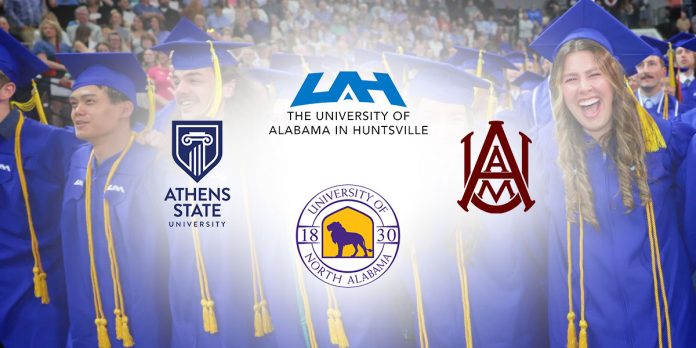HUNTSVILLE — When Alabama invests in higher education in the Tennessee Valley, it’s not just writing checks to universities – it’s strengthening the very backbone of America’s national defense and global competitiveness.
The growth of Redstone Arsenal and the cutting-edge work taking place in Cummings Research Park depend on a deep supply of brainpower, and our state has the responsibility to monitor and promote that supply.

Spanning 38,000 acres, Redstone Arsenal is America’s hidden powerhouse. It’s far more than a military base – it’s a federal center of excellence for space operations, missile defense, logistics, intelligence, and homeland security.
It serves as headquarters for the U.S. Army’s missile and aviation programs, the Missile Defense Agency, the Defense Intelligence Agency, and NATO’s MEADS program. NASA’s Marshall Space Flight Center calls Redstone home, and the new location of the U.S. Space Command is expected to bring 1,500 additional jobs to Huntsville in the near future.
Redstone’s economic numbers are staggering:
- $18 billion annual economic impact — nearly 10% of Alabama’s GDP
- 192,000 jobs in the Valley are tied to Redstone and its operations
- Over $50 billion in annual federal budgets are managed by Redstone agencies.
The scale of this operation makes this more than a Valley story – it’s a story about our nation’s security and viability.
Workforce Demand: Highly Educated
Redstone agencies employ more than 45,000 people, with projections to reach 50,000 within the next year. The FBI alone plans to grow from 1,500 employees today to 5,000 by 2028, with thousands more trained annually. These jobs require advanced education degrees in engineering, computer science, data analytics, cybersecurity, and much more.
In short, Redstone runs on brainpower and academic talent, and much of that pipeline of talent flows directly from Alabama’s universities.
Strategic Context: A Shifting Global Environment
Redstone’s missions are directly tied to evolving security threats:
- Russia: Army Materiel Command supports Ukrainian sovereignty with billions in weapons and supplies
- China: NASA leadership warns of intensifying competition in space, with potential claims on lunar territory
- Emerging Technologies: Hypersonics, directed energy, quantum computing, and artificial intelligence are under development and analysis at Redstone
- Domestic Security: The FBI’s Redstone operations are central to countering terrorism and internal threats
The Case for Investing in Higher Education
These challenges underscore the importance of a sustained, highly educated workforce pipeline. Every new challenge makes Redstone’s mission clearer—and Alabama’s role more critical.
The Valley’s four public universities — Athens State, Alabama A&M, the University of North Alabama, and the University of Alabama in Huntsville — have collectively awarded more than 53,000 degrees during the past decade. More than 90 percent of Redstone’s workforce holds a four-year degree or higher.
That’s a correlation that would be difficult to deny – the direct result of Alabama’s investment in higher education. The proof is undeniable: When Alabama funds higher education, the state helps fuel Redstone’s mission, bolsters national security, and drives billions into our economy.
Today, Alabama faces a defining moment. To keep Redstone strong and to secure Alabama’s future, the state must invest in higher education in the Valley. The stakes are national defense, economic growth, and global leadership.
Without sustained state investment in higher education, Alabama risks a shortfall in the advanced workforce required to maintain and grow Redstone’s operations. This would directly affect the nation’s defense posture, the state’s economic competitiveness, and the long-term viability of the Valley’s federal and corporate econsystem.
Investing in brainpower is not just good policy – it’s Alabama’s competitive advantage.
Policy Recommendation
Alabama must treat investment in higher education in the Tennessee Valley as a strategic policy priority. Specifically:
- Increase baseline funding for Athens State University, Alabama A&M University, the University of North Alabama, and UAH to expand STEM, cybersecurity, and data sciences programs
- Support workforce alignment initiatives linking university curricula with needs of Redstone agencies
- Create targeted scholarship and fellowship programs to retain Alabama graduates in Valley-based federal and corporate careers
- Sustain long-term capital investments in laboratories to ensure universities remain competitive nationally
Conclusion
The evidence is clear: Alabama’s investment in Valley higher education has already yielded extraordinary returns — measured in jobs, economic growth, and contributions to national security. Failure to continue and expand this investment risks undermining Redstone Arsenal’s future, diminishing the state’s economic strength, and weakening America’s defense capabilities.
Strategic investment in higher education is not discretionary; it is essential to Alabama’s and America’s future security and prosperity.
Ray Garner served in the Alabama Legislature from North Alabama and was a member of the Education Finance Committee in the Alabama House of Representatives.
Don’t miss out! Subscribe to our email newsletter to have all our smart stories delivered to your inbox.



